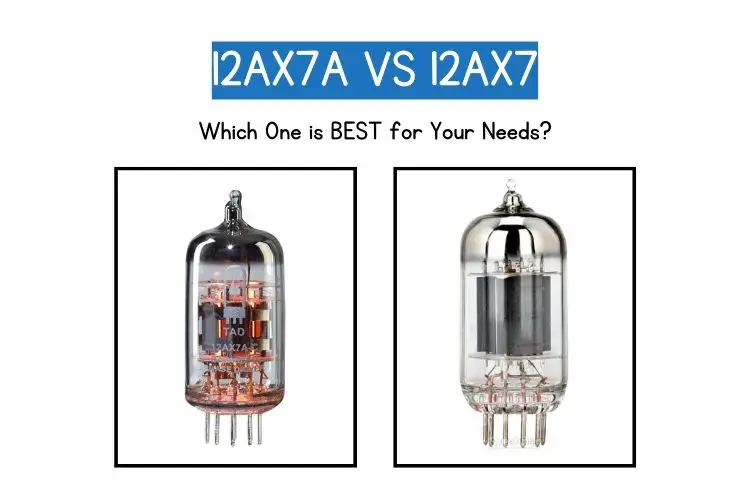With so many amp tubes on the market, knowing which one is best for you is essential, especially if you are a music professional or passionate about music.
Making the right decision can be pretty tough, as various tube amps work with different instruments. However, lucky for you, we are about to make things a lot easier for you.
| Differences | 12Ax7A | 12Ax7 |
| Amps | Fender, Marshall, Supro, and Vox | HiWatt, Boogie, Fender, Laney, and Soldano |
| Availability | Readily available | Less availability |
| Compatibility | Parallel and series filament heart circuits | Parallel filament circuits only |
| Durability | 4 – 6 years | 1 – 5 years |
| Gain | 100 mu | 100 mu |
| Heater Circuits | Parallel and series | Parallel only |
| Microphonic Noise | Lesser noise | More noise |
The two tube amps we will be discussing today are the 12Ax7A and 12Ax7. These are among the most popular amp tubes that professionals, as well as beginners, use for playing their music.
But the real question is, what is the difference between 12Ax7A and 12Ax7? Are 12Ax7A and 12Ax7 interchangeable? Let’s find out!
Table of Contents
12Ax7A Vs. 12Ax7- Analyzing the Differences
There are several variants of the 12Ax7 available in the market currently. And you will see an audible difference between all of them; this difference is what makes each suitable for different purposes. Let’s take a look at the distinctive characteristics of these tube amps.
12Ax7A Vs. 12Ax7- The Main Difference
The main difference between the 12Ax7 and 12Ax7A is that while the former has a parallel circuit, the latter can be used with parallel as well as series circuits.
The 12Ax7A has a controllable heater warm-up that can be used in almost all types of filament circuits. Except for these differences, the gain and other qualities are quite similar. Let’s take a closer look at these differences
12Ax7A Vs. 12Ax7: The Key Differences
Comparing the 12Ax7A and 12Ax7 tube amps seems as confusing as the EL-84 and 6v6. However, once we list down the key differences between the two, you will not have much trouble.
Moreover, all you need to remember is that the primary difference is that both circuits have heater circuit differences. The other properties are pretty much the same.
The 12Ax7A and 12Ax7 tube amps are quite similar, with minor differences. The 12Ax7 tube comes with variants, including the 12Ax7A AND 12Ax7B. Shuguang has introduced these.
The S suffix can also be found in other tubes, such as the 12Ax7LPS and ECC83S. The ‘S’ basically denotes the spiraling heater filament.
All the 12Ax7 tube amps feature spiral heaters. Therefore, the S suffix does not mean anything exceptional anymore.
In the more advanced tubes, the suffixes like 12Ax7A and 12Ax7B are simply product names with no significant value. However, they do indicate the model they originally belonged to.
12Ax7A Vs. 12Ax7
Here is a list of the main differences between the 12Ax7A and 12Ax7 tube amps:
1. Compatibility: 12Ax7A Vs. 12Ax7
The major difference between the 12Ax7A and 12Ax7 is the compatibility of both tubes.
The 12Ax7A is compatible with both the parallel and series circuits, while the 12Ax7 only supports parallel circuits. The former is more versatile, and so it is more widely used.
The 12Ax7 model came out first. But users wanted more options, so it was given an upgrade, and the 12Ax7A tube amp was introduced. Apart from working with an additional circuit type, it was also more affordable.
In the 12Ax7A tube amp, a regulated heater warms up the tube amp, preparing it for use in series or parallel circuits. Therefore, the 12Ax7A is mostly preferred over the 12Ax7 tube amp.
2. Durability: 12Ax7A Vs. 12Ax7
Another factor to consider is the durability of the 12Ax7A and 12Ax7 tube amps. Are you on a budget?
Do you not want to invest in a tube amp repeatedly, or do you just want to buy a good-quality tube amp only once? We have good news- both the 12Ax7A and 12Ax7 tube amps will last you for at least three years.
The life of any tube amp primarily depends on its usage. Both the 12Ax7A and 12Ax7 tubes can last you for over five years if you use them with care. The main contributing factors to lessening life are heat and poor handling.
The current between the cathode and anode is the main cause of tube wear and tear.
As the tube is used, it currently runs between these two amps, taking up the tube’s durability. However, even after a considerable time, both tubes will work fine.
On average, the 12Ax7A tubes last users for 4 – 6 years, while the 12Ax7 tube can be used for 1 – 5 years. We suggest replacing the tube amp after 5000 to 10000 hours.
In the gain stage, the 12Ax7A and 12Ax7 may work for a long since it produces lesser heat. Although more reliable, parallel circuits use more energy compared to series circuits.
The mix of series and parallel circuits logically gives the 12Ax7A tube amp a longer tube life; this is a significant advantage.
The Sylvania Electric company has developed an improved 12Ax7A design with a helically wrapped heater structure that lasts pretty long. Thus, the 12Ax7A tube amp is a better choice.
3. Gain: 12Ax7A Vs. 12Ax7
The high and low gain performance of 12Ax7A and 12Ax7 tubes has been a hot topic of discussion. The dual-triode 12Ax7 tube has a high gain as compared to the 12Ax7A.
Overall, the 12Ax7 models differ in gain by only a few points, so it is not a significant differentiating factor.
Let’s talk a little more about the 12Ax7 tube amp’s gain. Both the 12Ax7A and 12Ax7 tube amps have eight pins, so the differences are quite noticeable. The 12Ax7A preamp tube gives the highest gain and better tonal quality.
Therefore, you get a broad-spectrum, expressive tone with clean and controlled frequency response.
The best preamp tube for all the key gain stages is undoubtedly the Bugera 12Ax7A. It has been continuously among the top-rated tube amps and for all the right reasons.
It effectively lessens properties like noisy floor and tone.Both the 12Ax7A and 12Ax7 tubes have a gain of 100 mu. The tone necessarily is not better with a higher tone.
Therefore, we recommend experimenting with various 12Ax7 tubes before using them in your professional music gigs and seeing what works best for you. Since both these tubes have a similar gain, there is no definite winner.
4. Heater Circuits: 12Ax7A Vs. 12Ax7
The 12Ax7 alphanumeric name is inscribed on the side of most of the tube amps. It is not simply a model number but also tells you a lot more about it. Let’s take a closer look at this tube amp’s name and break it down:
The number ’12’ denotes the heater (a component that gives an orange light illumination when the tube is switched on).
It means that both the 12Ax7A and 12Ax7 tubes need 12 volts to function. Next, the letter ‘A’ means that the tube functions as an amplifier.
The X stands for the tube amp’s electrical properties, such as the resistance, gain, etc. The ‘7’ stands for the number of pins actively running in the tube amp.
In the initial models, the parallel filament circuits were merely applications for the 12Ax7.
Then came the 12Ax7A model, which has been designed to work in circuits that either uses the series or the parallel filament circuits. However, most circuits nowadays are parallel only.
Thus, though the 12Ax7 model supports the more common parallel circuits, the 12Ax7A is a winner since it works with series as well as parallel circuits, giving the user more options.
4. Microphonic Noise: 12Ax7A Vs. 12Ax7
Let’s discuss another vital factor when choosing between the 12Ax7A and 12Ax7- microphonic noise. Both tubes can detect vibrations, converting them into signals. This phenomenon is called Microphony.
All the vacuum tubes have Microphony to some extent. The impact is considerably more noticeable with high-gain tube amps like 12Ax7. This lessens the possibility of encounters.
The 12Ax7A tube amp uses a shorter plate than the 12Ax7. The former’s design explicitly resolves Microphony issues.
The shorter plate also has a spiral filament pattern that further improves the Microphone function. Therefore, the clear winner here is the 12Ax7A.
5. Tone: 12Ax7A Vs. 12Ax7
Next, we will talk about the tonal differences between the 12Ax7A and 12Ax7 tube amps.
Both tubes offer a smooth and clear tone that works well with most music genres. However, there is a variation between the microphonic noise, but it improves as you move across the full spectrum.
There have been little to no weak points or spikes in the low, mid, or high ends. In fact, the middle response is pretty good quality. The bottom end is rich and warm, while the high ends are exceptionally smooth.
Due to the shorter plate design, the 12Ax7A tube has a more intensified microphonic noise level and low audio. Therefore, the 12Ax7 tube amp\s tone quality is much better than the 12Ax7A.
Are the 12Ax7A and 12Ax7 Tube Amps Interchangeable?
The 12Ax7A and 12Ax7 tube amps are interchangeable since they are not too different from one another. However, not interchanging them is a safer option as it limits damage.
Furthermore, it is imperative that you correctly document and diagram your circuit and instrument before replacing one model with the other. Ideally, none of the two tubes should be damaged when interchanged.
What Tubes Can Replace 12AX7?
The following tubes can replace the 12Ax7 tube amp:
- ECC83
- 12AX7A
- 12AX7WA
- 7025
- 5761
- 6057
- 6681
- 7494
- 7729
- 7025
- ECC83
- 6L13
- 12DF7
- 12DT7
- 5751
- 7025A
- B339
- B759
- CV4004
- E83CC
- ECC803
- M8137
Conclusion
When it comes to choosing between the 12Ax7A and 12Ax7 tube amps, we suggest emphasizing the manufacturer as well as the components that have been used in making the tube amp.
Moreover, consider the quality, the purpose you need it for, and the duration. Although most of the qualities of both these tubes are similar, the 12Ax7A is slightly more versatile and an upgrade of the 12Ax7 tube amp.
Both these tubes have overall smooth audio profiles that feature powerful bass. The 12Ax7A and 12Ax7 tubes are neither too sweet to the ears nor neither too high.
With sweet and warm highs and mids, we recommend trying out both at a shop or using a friend’s or family’s tube amps before purchasing them.
Although both these models are not as popular as some of the leading amp tubes, the 12Ax7A is used more widely than the 12Ax7 tube amp.
The former is a more affordable option besides supporting series and parallel filament circuits.
Other factors when picking between the 12Ax7A and 12Ax7 preamp tubes are how you plan to use them and if your instrument supports them correctly.
Some users also interchange the two tubes, but this can cause problems sometimes. Therefore, to minimize damage and maximize efficiency, we recommend getting the tube that you need and avoiding interchanging them.



![HERE’S What Happened to the Soul Singer Al Green [2023 Update]](https://performerlife.com/wp-content/uploads/2023/04/what-happened-to-al-green-211x150.jpg)
